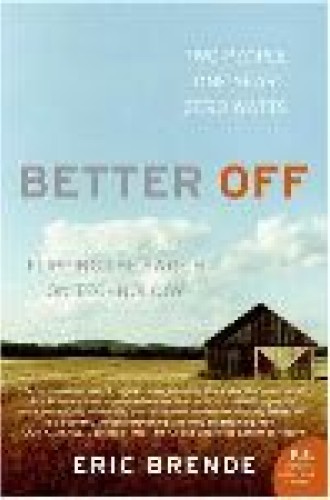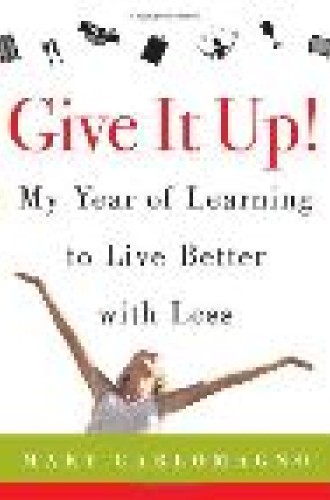Enough already
During the spring semester of my first year of college, my roommate and I determined that we would wear only ten outfits between us. We had just watched the movie Romero, about the Salvadoran archbishop martyred for his work with the poor, and had concluded that we’d had it with the consumptive lifestyles of North Americans, our own included. So we decided to choose one symbol of materialism—an abundance of clothing—from which to declare our independence. We hauled out all of our clothes and sorted through the piles, carefully weighing how versatile each blouse was and which sweaters matched which pants. Then we hung up the chosen pieces, boxed up the rejected ones, and prayed that no one on campus would think us too weird.
Three recently published books that record their authors’ experiments in living with less suggest that frugality is more fashionable than my plastic bag–washing Mennonite grandmothers could have guessed. Living simply has long been an ethic for certain religious folks, a necessity for the poor, and an aesthetic for the countercultural privileged, but it is significant that in the era of McMansions and Hummers three major publishers have determined that enough readers would purchase frugality narratives to make their publication profitable (the irony of which is hard to miss). These books join a glut of self-help simplicity manuals, a major publisher’s imprint focused on frugal living, and a glossy mag devoted to the aesthetic of simplicity. It’s enough to make one wonder whether America is reaching a tipping point of overconsumption and whether not buying stuff is now more fashionable than buying it.
Self-restraint is hardly a hallmark of North American life, but thanks to globalization some consumers can now buy so much stuff that they’re becoming sick of it, and skyrocketing consumer debt and job insecurity are pushing many others toward involuntary simplicity. It’s hardly surprising, then, that folks who have never heard of the Shakers are checking out Frugal Living for Dummies from the library.
This rising trend toward simplicity in our culture raises several fascinating questions. Do the voluntary simplicity movement and its commercial iterations overlap with the long-standing Christian tradition of living with less? How does one downshift without becoming snooty toward neighbors and friends who are shifting into higher consumer gear—or at least wishing they could? Finally, how should we treat the pesky consumer desire that can dog even the most committed anticonsumer? Is it a sin of greed to be confessed or an opportunity for self-examination to be embraced?
Although none of these writers claim religious motives for their simplifying journeys, they experience a symptom with which many people of faith would identify. Eric Brende calls it cultural indigestion: a disgust with North American devotion to all things mechanized and purchasable.
Brende, a graduate student at MIT when he wrote Better Off: Flipping the Switch on Technology and now a rickshaw driver and soapmaker, defines the malady mostly in terms of Americans’ overdependence on technology. For him, the remedy was a year living with people he christened the Minimites because of their commitment to minimizing the tyranny of technology in their lives. While he does not disclose the identity or exact location of the community, he does reveal that it is a collection of Amish, Mennonite and previously mainstream Americans who joined together “somewhere deep in America’s heartland” to “reclaim their lives from machines.”
Brende and his wife moved into a house in the Minimite community and lived without a refrigerator, a computer, a telephone and, eventually, a car. As they joined their new neighbors in the labors of fieldwork and housekeeping, Brende pursued his central question: “Was there some baseline of minimal machinery needed for human convenience, comfort, and sociability—a line below which physical labor was too demanding and above which machines began to create their own demands?”
Judith Levine’s simple-living experiment, as recounted in Not Buying It: My Year Without Shopping, was less drastic than Brende’s—she retained her Internet access and her car and didn’t halt construction on an addition to her house. Instead of focusing on machines as the burglars of people’s time, fuel, loyalty and money, Levine hones in on overconsumption. Her case of cultural indigestion came to a head in December 2003, when she had maxed out one credit card and was “tapping the ATM like an Iraqi guerrilla pulling crude from the pipeline.”
So Levine and her partner, Paul, decided to spend a year buying only what they defined as necessities, although she admits to sometimes fudging on her own definition of what is truly necessary. During the course of her buy-nothing year, she reflected on everything from $15 socks to a cell-phone tower controversy in rural Vermont, to the burgeoning consumption of security products after 9/11, to the sorry state of publicly funded institutions like libraries. While Levine’s commitments were less sweeping than Brende’s, her social and political analysis is more incisive and her self-awareness more profound.
Then there is the least radical experiment of the three, recounted in Give It Up: My Year of Learning to Live Better with Less. Mary Carlomagno, the founder of a company that specializes in “clutter control,” gave up one luxury (such as alcohol, newspapers or dining out) per month for one year.
Her account reminds me of the Sex and the City episodes I’ve seen, what with her fetish for expensive footwear and her twice-weekly $30-per-meal sushi habit. Carlomagno’s prose, though, is not particularly graceful, and her analysis of urban American lifestyles much more vapid than the sitcom’s Carrie Bradshaw’s. Her central question—What intangible gifts can I gain from giving up my consumptive ways?—does hold potential, however, and readers who would yawn or gasp their way through Levine’s much edgier tome might actually be inspired to temper their own addiction to television or taxis.
So is there any overlap between these authors’ versions of simpler living and the one pursued by Christian downshifters in the tradition of Doris Janzen Longacre’s 1980 classic Living More with Less? Brende and Levine seem dubious about organized religion, and Carlomagno doesn’t mention it. Brende bristles at the exclusivity and dogmatism he discovers among the Minimites, even while their solemn, chant-filled services remind him of his own Catholic tradition. Levine, a Jewish atheist, stops by a church on Christmas Eve and finds herself longing for “something that religions offer in abundance: the permission to desire wildly, to want the biggest stuff—communion, transcendence, joy, and a freedom that has nothing to do with a choice of checking accounts or E-Z access to anything.” Then, in an uncharacteristic lapse into platitude, she concludes that people don’t need religious faith to obtain any of these ideals; they need only “the faith that it is possible.”
Granted, Levine proves her own point: that a person of no faith can supplant her craving for material things with a longing for the ideals of justice and equality and freedom. Still, she gives too little attention to the fact that many downshifters resist consumption not only because of cultural indigestion but also because of a powerful devotion to following Jesus Christ or some specific religious tradition. It is unfortunate that in her frequent forays into the voluntary simplicity movement Levine did not visit any of a number of intentional Christian communities that foreground simple living. Had she looked up the Simple Way in Philadelphia, Reba Place in Evanston, Illinois, or Rutba House in Durham, North Carolina, she might have found wise and broad-minded companions on the sometimes lonely journey away from overconsumption.
Cultural indigestion can motivate us to begin disentangling ourselves from consumptive lifestyles, but it can also leave us feeling cynical and depressed. It is precisely at this point of despondency that many of us rely on the combined resources of community and faith to provide accountability, sustenance and hope. Communities that embrace simplicity can provide a kind of reverse peer pressure so that purchasing a high-end coffeemaker or large-screen TV violates a social norm rather than fulfills it. And Christian faith, which reminds us of our commitment to values that are not purchasable and brings us joy apart from possessions, can nourish us at moments when our simplifying spirits flag.
Of course, countercultural social mores that are fused with religious conviction are even more prone than secular mores to morph into moralism. Self-righteousness remains a common downfall of books written about simplicity and communities that espouse it.
Social capital among voluntary simplifiers is calibrated not by how much one owns but by how little one needs. Environmentalist Bill McKibben has called the voluntary simplicity movement “slightly submerged consumerism”: its adherents—himself included—“consume inconvenience, turning it into a pleasurable commodity; it becomes the fuel for my own sense of superiority.” Critic James Twitchell goes so far as to call the movement a modern potlatch that reenacts the renunciation of material possessions by Native American chiefs, which is a sign of prestige and power. “Now potlatch is practiced as a way of middle-class coping,” writes Twitchell. “I can’t really afford it, but I could have it if I wanted. You, however, shouldn’t even want it.”
The authors of these simplicity narratives write from various levels of awareness of the potential pitfall of moralism. Somewhere between Carlomagno’s obliviousness and Levine’s meticulous self-examination lies Brende’s self-deprecating, searching and sometimes preachy prose. In his epilogue, unabashedly titled “Recipe for a Leisurely, Laborsaving Life,” Brende says that he and his family “simply don’t need much money, or miss it.”
I can easily believe the first claim but am a tad suspicious of the second, in part because he speaks not only for himself but also for his wife and three children. True: living with less, at least when one chooses to do so, can lead to one having fewer desires over time. Also true: children raised in downshifted families learn creative and pleasurable play that requires neither an Xbox nor a DVD player. Yet claiming zero consumer desire for both oneself and one’s family? It would have been more helpful for Brende first to admit to the human craving for stuff that can accompany even the most sincere commitment to frugality, and then to explore how to deal with such desires.
Levine avoids sanctimony by emphasizing the question of desire rather than dismissing it. “There is no way to approach the problem of overconsumption without investigating the feelings that surround fantasizing, getting, and owning our stuff,” she admits in the first chapter. Two weeks before her experiment was to begin, she was overcome by an appetite for things, and in one store she found herself “distracted—no, deranged—by the hundred-thousand housewares on display. My own kitchen and everything in it suddenly appear hopelessly shabby,” she writes. “Our cloth napkins are soiled. Shouldn’t I pick up a half dozen? . . . And isn’t this a cunning and useful gadget? It’s a . . . a . . . gilhooly!”
Levine also confesses to feeling smug delight when her partner waffled on some of their original definitions of necessity halfway through the year: “Condemn anticonsumerist moralism all I want, it seems impossible to forgo judging consumption—or to avoid feeling righteous when abstaining,” she writes. Along the same lines, almost 80 percent of respondents to a study conducted by economic sociologist Juliet Schor said that most Americans are “very materialistic.” Only 8 percent of respondents, however, considered themselves to be so. Apparently humility is as challenging as simplicity, and moralism as tempting as consumerism.
But are the choices really as stark as this: smug but planet-saving asceticism versus whole-hog but honest materialism? Or is there some way to be both candid about our consumer cravings and faithful to our Christian commitments?
North American Christians are probably guilty of avarice more often than of any of the other six deadly sins, but conceptualizing consumer desire solely as sin may not be the best way to help us out of this dilemma. If we imagine that confessing our greed and doing penance by hauling a couple of boxes to the thrift store will magically erase our craving for more stuff, we will only sink into lower registers of guilt for our inconsistencies and despair over our ineffectiveness. Those of us reared in the most consumptive society in history shouldn’t be surprised if greed clings to us for generations, with climate change becoming the most distressing result of our iniquity to be visited upon our children.
Yet attempting to rid ourselves of desire might not be the best solution either. I doubt that Levine is alone in her reluctance to ally herself with “any movement, right or left, that starts by telling people not to desire.” Perhaps a more realistic and ultimately more sustainable path to living more with less is first to accept the fact that all humans, the poor included, invest objects with meaning: the house or hut signifies safety, the bed or blanket symbolizes comfort, the car or bike stands for freedom. As sensory creatures also capable of abstract thinking, we use material goods as proxies for those intangibles that we cannot own. When we reflect on these desires rather than eschew them, we may be more able to name the elusive ideal we associate with that new couch or pair of skis. Perhaps then we can skip the credit card swipe and, with God’s help, go straight for the deeper thing that we desire. With practice we may also be moved to work toward the realization of both the intangible ideals and their manifestations for those in our world who lack them.
I still think that my college roommate and I were on to something, and these authors point us in the right direction. Though it’s true that most of us will never be free from consumer desire, it’s incumbent upon those of us in the notorious 10 percent who consume 90 percent to consider how we might live with less. It doesn’t much matter whether we do so out of consumptive weariness, self-righteousness, a bourgeois aesthetic or commitment to the way of Christ. Now that we’d need five more planets if everyone on Earth consumed like we do, motives matter very little.








